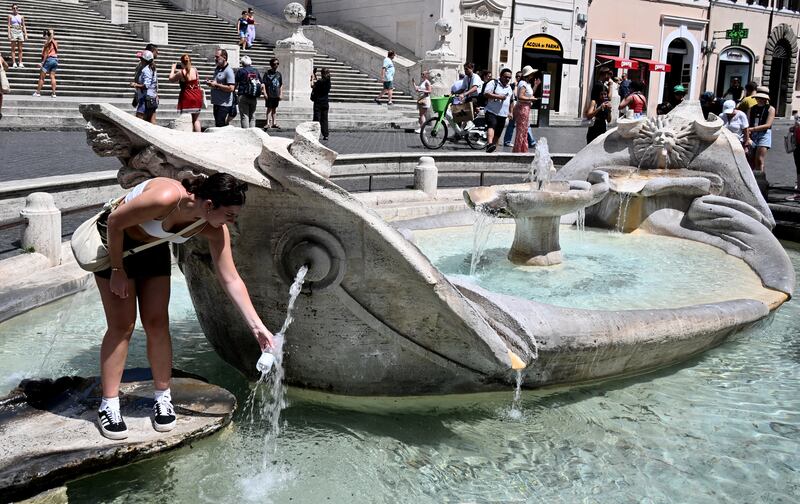Global temperatures headed towards alarming highs and extreme weather proliferated as the world’s two biggest polluters, China and the United States, sought on Monday to resume climate talks.
With scientists saying the target of keeping global warming within 1.5 degrees of pre-industrial levels is moving beyond reach, evidence of the crisis was everywhere. A remote town in China’s arid northwest, Sanbao, registered a national record of 52.2 degrees.
Wildfires in Europe raged ahead of a second heatwave in two weeks that was set to send temperatures as high as 48 degrees. In the US, a quarter of the population fell under extreme heat advisories, partly due to a heat dome that has settled over western states.
“In many parts of the world, today is predicted to be the hottest day on record,” tweeted Tedros Adhanom Ghebreyesus, director general of the World Health Organisation.
Travel trends for the year ahead: where, when and how Irish holidaymakers are booking trips in 2024
In pictures: Crowds take to the beaches amid record high September temperatures
Greece reinforces firefighters as massive wildfire shows no sign of abating after 10 days
Wildfires in Greece force more evacuations as other European blazes are brought under control
“The #ClimateCrisis is not a warning. It’s happening. I urge world leaders to ACT now.”
In a resumption of diplomacy on global warming between the two superpowers, US climate envoy John Kerry met Chinese counterpart Xie Zhenhua in Beijing, urging joint action to cut methane emissions and coal-fired power.
“In the next three days we hope we can begin taking some big steps that will send a signal to the world about the serious purpose of China and the United States to address a common risk, threat, challenge to all of humanity created by humans themselves,” Mr Kerry said, noting the proliferation of storms and fires.
“It is toxic for both Chinese and for Americans and for people in every country on the planet.”
Prolonged high temperatures in China are threatening power grids and crops and raising concerns about a repeat of last year’s drought, the most severe in 60 years.
Typhoon Talim was gaining strength and due to make land at night along China’s southern coast, forcing the cancellation of flights and trains in the regions of Guangdong and Hainan. In South Korea, torrential rains left 40 people dead as river levees collapsed causing flash floods. They followed the heaviest recorded rain in the capital Seoul last year.
An anticyclone nicknamed Charon could cause Europe to break its highest recorded temperature of 48.8 degrees.
Tourists in Rome, Italy’s capital, cooled themselves under giant fans set up outside the Colosseum and took turns to drink from a fountain near the Spanish Steps.
In Spain, temperatures were predicted to rise to as high as 44 degrees in some regions. However, a forest fire on the island of La Palma in the Canaries that forced the evacuation of 4,000 people was being brought under control as temperatures fell, local official Sergio Rodriguez said in an interview on the country’s broadcaster, TVE.
In Greece, villagers were ordered to leave their homes and hundreds of children were evacuated from a summer camp as two separate wildfires fanned by strong winds damaged houses to the southeast and west of Athens on Monday, authorities said.
The fire that broke out in the village of Kouvaras, about 27km from the Greek capital, spread fast amid erratic winds, a Greek fire service official said.

About 200 firemen with the help of around 20 soldiers, 68 engines and 16 aircraft were trying to control the flames, the official added.
Greek television showed several houses and cars gutted by the blaze and thick white smoke billowing from burning vegetation.
Scientists have long warned that climate change, caused by CO² emissions from burning fossil fuels, will make heatwaves more frequent, severe and deadly.
The European Union’s Copernicus Climate Change Service said 2022 and 2021 were the continent’s hottest summers on record.
Buildings and roads are storing heat during the day and releasing it at night, causing temperatures to remain up to 4 degrees higher than in surrounding areas and contributing to health risks for vulnerable people, said Andreas Flouris, associate professor of physiology at Greece’s University of Thessaly.
“We’ve seen that this night-time temperature increase in cities often contributes a lot more than we thought to mortality,” Mr Flouris said.

As many as 61,000 people may have died in Europe during heatwaves last summer, with a repetition feared this season.
“My worry is really health – the health of vulnerable people who live just below the rooftops of houses which are not prepared for such high temperatures,” said Robert Vautard, a climate scientist and director of France’s Pierre-Simon Laplace Institute. “That could create a lot of deaths.”
In Cyprus, a 90-year-old man died and three people were in hospital with heat stroke symptoms as temperatures spiked at over 45 degrees on Saturday, authorities said. The heat dome across the western US also helped to generate heavy rains in the northeast, claiming at least five lives. The heat warnings spread as far as Florida.
In California’s Death Valley, tourists gathered in Furnace Creek on Sunday in anticipation of witnessing the hottest recognised temperature on earth: 134 degrees Fahrenheit (56 degrees) in 1913, according to the World Meteorological Organisation.
They cheered as a digital display of 132 degrees Fahrenheit ticked up to 133 degrees while national park rangers stood by in case anyone succumbed to heat stroke.
Carlo Buontempo, director of the European Union’s Copernicus Climate Change Service, said there was a clear pattern of heatwaves becoming more common as predicted by scientists.
“We are already in uncharted territory, completely. We have never seen anything like this in our living memory, in our history,” Mr Buontempo said. – Reuters




